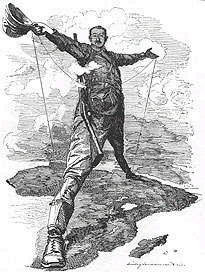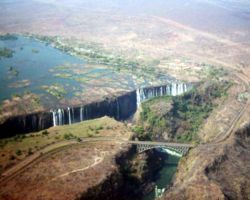Cape-Cairo railway
The Cape to Cairo Railway is an uncompleted project to cross Africa from south to north by rail. This plan was initiated at the end of the 19th century, during the time of colonial rule, largely under the vision of Cecil Rhodes, in the attempt to connect adjacent African possessions of the British Empire through a continuous line from Cape Town, South Africa, to Cairo, Egypt. While most sections of the Cape to Cairo railway are in operation, a major part is missing between Sudan and Uganda.
Contents
Reasons for its construction
British colonialism in Africa is closely linked to the concept of the Cape to Cairo Railway. Cecil Rhodes was instrumental in securing the southern states of the continent for the British Empire and envisioned a continuous "red" link of British dominions from North to South. A railway would be a critical element in this scheme to unify the possessions, facilitate governance, enable the military to move quickly to hot spots or conduct war, help settlement, and foster trade. The construction of this project presented a major technological challenge.
Why has it not been completed
British interests had to overcome not only the formidable obstacles posed by country and climate, but also interfering ambitions by other powers. The French attempted an West-East connection of their possessions from the Western Sahara or French North Africa to Djibouti. Their attempts were foiled at the Fashoda incident. The Portuguese tried unsuccessfully to link Angola and Mozambique. Opposition to British rule in South Africa was settled after two Boer Wars. Germany had secured a critical piece of real estate in East Africa that precluded completion of the North-South link. However, with the defeat of Germany in 1918 most of this territory fell into British hands and politically the link was closed. However, while after 1918 the British Empire possessed the political power to complete the Cape-Cairo Railway, economic issues precluded its completion between the World Wars. After World War II, the national struggles of the African peoples, and the demise of colonialism removed the foundations for its completion.
Current Links
The Northern section
Egypt has a rail system that as early as 1856 connected Alexandria and Cairo, and that currently goes as far south as Aswan. In Egypt the gauge is 1.435 m. After a ferry link up the Nile, the railway continues in Sudan from Wadi Halfa to Khartoum at the 1.067 m gauge. This part of the system was started by Lord Kitchener in 1897 when he subjugated the Mahdist uprising. Further rail links go south, the most southern point being Wau. However, a large part of the Sudanese rail operations is currently in disrepair due to political turmoil.
The Uganda railway
East Africa has a network of narrow gauge (1.000 m) railways that historically grew from ports on the Indian Ocean and went westward, built in parallel under British and German colonial rule. The furthest string north was the Uganda Railway. Eventually these networks were linked, so that today there is a continuous rail connection between Kampala, Uganda, on Lake Victoria to the coastal cities of Mombasa in Kenya and Dar-es-Salaam in Tanzania. Up to the break-up of the East African Community in 1977 these companies operated as East African Railways, but operate today as different national companies: the Uganda Railways Corporation, the Kenya Railways Corporation, and the Tanzania Railways Corporation.
TAZARA link
From Dar-es-Salaam, a separate 1,860 km link to Kapiri Mposhi in Zambia was completed after six years by workers of the People's Republic of China in 1976. This Tanzania-Zambia-Railroad (TAZARA) was built to connect landlocked Zambia and its mineral wealth to the port at the Indian Ocean, independent from connections through South Africa or at that time Portuguese controlled territory. Yet, while not intended in the grand picture of the Cape to Cairo railway, the TAZARA fills a critical link. This connection is at the same 1.067 m gauge as the system in the southern part of Africa.
The Southern section
The Southern section was completed during British rule before the First World War and has an interconnecting system of national railways using the Cape-gauge of 1.067 m. Construction started from Cape Town and went parallel to the Great North Road to Kimberley, further through a part of Botswana to Bulawayo. From this junction the link proceeds further north, today operated by the National Railways of Zimbabwe, to the Zambezi crossing. The Victoria Falls Bridge was completed in 1905. The connection is picked up by Zambia Railways and continues to Kapiri Mposhi which the transition point to the TAZARA link to Tanzania.
Future
The concept of the Cape to Cairo Railway is not dead. While the current turmoil in Sudan is an obstacle to its completion, tangible concepts have been forwarded to complete the link between Sudan and East Africa for economic reasons. [1] It has been suggested that such a link would facilitate trade between the Mediterranean countries and Europe and the Sub-Saharan part of Africa and be of economic benefit.
References
- Tabor, George, The Cape to Cairo Railway & River Routes (2003), London: Genta. ISBN 0-9544847-0-3.
See also
External links
de:Kap-Kairo-Plan fr:Chemin de fer Le Cap-Le Caire nl:Kaap-Caïro-spoorweg no:Kapp til Kairojernbanen



